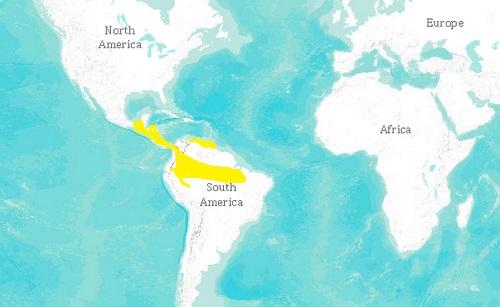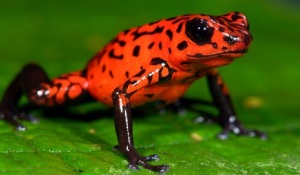What is in a name?
Local Amerindians in the Amazon rainforest used toxins from the skin of these frogs to poison the tips of their blow darts, therefore the name poison dart frog.
Taxonomy
- Kingdon: Animalia
- Phylum: Chordata
- Class: Amphibia
- Order Anura
- Suborder: Neobatrachia
- Family: Dendrobatidae
0
Physical Features
- Poison dart frogs have bright colorful bodies. Their color is associated with toxicity and alkaloids. It is the skin that contains the poison.
- All species of dendrobatidae family are somewhat toxic. Toxicity varies among species.
- They are aposematic organisms, meaning that their coloration gives warning signal to predators. Another aposematic organism is the larva of the monarch butterfly.
- Depending on their habitat they can be red, green , blue, yellow, copper, gold or black, or a combination of colors; solid or patterned.
- Poison dart frogs raised in captivity do not develop toxicity.
- Their toxicity comes from the chemicals in their prey which collects in the glands of their skin.
- Males are the same size as females.
Distribution and Habitat
- The poison dart frog, a species of the dendrobatidae family, is native to Central and South America.
- These amphibians live in tropical and subtropical, humid environments near sources of water.
- Their distribution extends through the tropical rainforests of Bolivia, Peru, Costa Rica, Brazil, Guiana, Panama, French Guyana and Nicaragua.
- The poison dart frog is an introduced species in Hawaii.

Poison dart frog distribution map. Source: IUCN Red List of Threatened Species
Size and length
- Length varies depending on the species. The smallest are 0.59 inches or 1.5 centimeters and the largest 2.4 inches or 6 centimeters in length.
- They weight 1 oz on average.
Behavior
- Poison dart frogs are diurnal animals. They are more active in the morning.
- Males and females make very good parents.
- They are territorial animals and they can be aggressive when it comes to defending their territory.
- They make loud vocalizations to attract females.
Diet
- These amphibians are carnivores. They feed on spiders, ants, termites and flies. They sequester toxins from their prey in the glands of their skin.
- They use their long sticky tongues to eat their prey.
- When in captivity they eat crickets and fruit flies and do not develop the toxicity in their skin as when in the wild.
Threats
- Habitat loss due to farming and logging. Poisoning of sources of water due to mining.
- Chytrid disease is a parasite that attacks poison dart frogs.
Reproduction
- Males attract females by making loud vocalizations.
- Females lay eggs on leaves, roots or the forest floor. The eggs are protected by a gelatinous substance.
- The male fertilizes the eggs externally, just like fish do.
- It takes two weeks for the tadpoles to hatch.
- The male carries the tadpoles on their sticky backs to the forest canopy where they are fed small invertebrates.
- It takes about 3 months for tadpoles to develop into small frogs. They develop hind legs first and then front legs, then their tails get absorbed and they are ready to walk on land.
Predators
- Because of their toxicity the poison dart frog has one natural predator, the snake Leimadophis epinephelus have developed immunity to their venom.
Life Expectancy
- About 10 to 15 years in captivity.
Conservation status
- The IUCN Red List of Threatened Species lists the poison dart frog as “least concern” because it its widely distributed in its range and has a healthy population growth.
Additional Facts
- There are more than 175 discovered species of poison dart frogs
- The most toxic species is the Phyllobates terribilis or golden poison frog. It has enough venom to kill 10 to 20 men.
- Chemicals from their skin may have medicinal value.
- Their poison can cause nausea, swelling, paralysis and in the worst case death.
References and further research
The Evolution of aposematic coloration in distasteful prey: A family model

